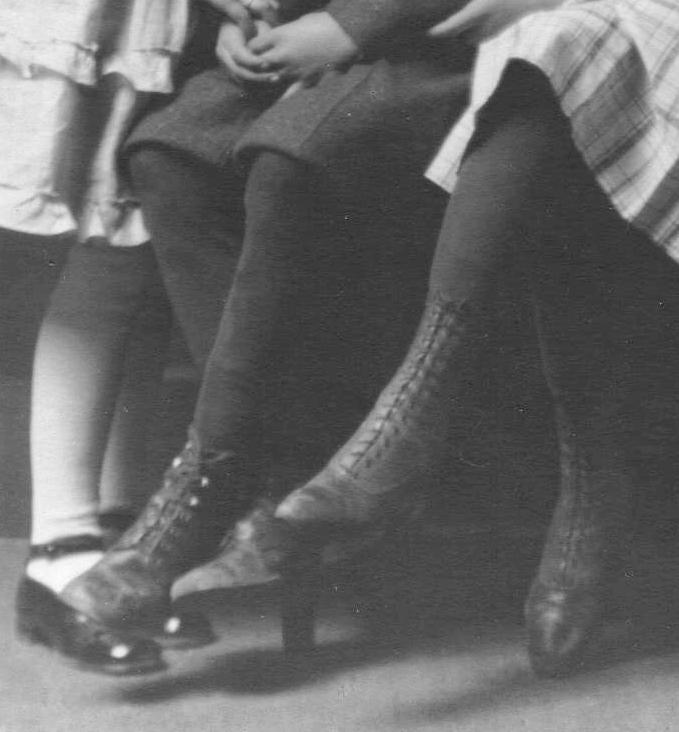
United States Boys' Clothes: Footwear Closures -- Chronology

Figure 1.--This unidentified portrait shows two girls and their little brother. It is undated, but looks likes the 1910s. The children look to be about 8-14 years old. The girls have ringlet curls and huge hair bows. Their brother wears a knickers suit. All the children have long stockings. Norice the varied footwear. The girl with white long stockings wers strap shoes with clasp closures. The other two children have lace up shoes. Notice the older girls high shoes with an incredible number pf eyelets. It must have been a real task sorting that out in the morning.
|
|
Footwear closures used have varied over time. This has included both fashion trends and technological develoments. Low-cut buckle shoes were standard in the 18th century, although we do not hsve much information. Clogs were common in Europe, but we have no information yet about America. We know much more about the 19th century. We note low-cut shoes in the early-19th century, but we do not yet have much information about closures. With the development of photography do we begin to have detailed information, but not at forst. Dags and Ambros were commonly posed so we can not se the footwear (1840s-50s). With the appearance of the CDV we suddently have a wealth of detailed informaion (1860s). We note high-top shoes becoming popular in the second half of the 19th century. We are not sure why. As far as we can tell it was essentially a fashion development. They often had button closures. The photographic record suggests that high-top styles were virtually universal in America. This can easily be observed in the photographic record. They were much more common in America than any other country. We are not sure why button closures became so important at mid-century and were so popular for an extended period. The chronological trends have varied from country to country. Suddenly button closures in America after several decades of dominating footwear very quickly disappeared in the late-1900s and early-1910s. Since then laces have dominted male footwear becoming virtually universal as far as closures go. This included boy's footwear. At first this mean largely-high top shoes. We also see boot like footwear with a rediculous number of eyelets to lace (figue 1). Younger children mught have strap shoes and sandals with clasp closures which did not require tying shoe laces, a difficult task for younger boys. Unlike Europe, school-age boys did not commonly wear these styles. They were, however, popular with girls of all ages. strap We see new methods in the late-20th century: spring snaps, velcro, and zippers. Velcro was especially popular for younger children who can not yet tie their laces.
The 18th Century
Low-cut buckle shoes were standard in the 18th century, although we do not hsve much information. Clogs were common in Europe, but we have no information yet about America.
The 19th Century
We know much more about the 19th century. We note low-cut shoes in the early-19th century, but we do not yet have much information about closures. With the development of photography do we begin to have detailed information, but not at forst. Dags and Ambros were commonly posed so we can not se the footwear (1840s-50s). With the appearance of the CDV we suddently have a wealth of detailed informaion (1860s). We note high-top shoes becoming popular in the second half of the 19th century. We are not sure why. As far as we can tell it was essentially a fashion development. They often had button closures. The photographic record suggests that high-top styles were virtually universal in America. This can easily be observed in the photographic record. They were much more common in America than any other country. We are not sure why button closures became so important at mid-century and were so popular for an extended period.
The 20th Century
The chronological trends have varied from country to country. Suddenly button closures in America after several decades of dominating footwear very quickly disappeared in the late-1900s and early-1910s. At the same time there was a shift from knee pants to knickers. Since the 1910s, laces have dominted male footwear becoming virtually universal as far as closures go. This included boy's footwear. At first this mean largely-high top shoes. We also see boot like footwear with a rediculous number of eyelets to lace (figue 1). Younger children might have strap shoes and sandals with clasp closures which did not require tying shoe laces, a difficult task for younger boys. Unlike Europe, school-age boys did not commonly wear these styles. They were, however, popular with girls of all ages. strap We see new methods in the late-20th century: spring snaps, velcro, and zippers. Velcro was especially popular for younger children who can not yet tie their laces.
HBC

Navigate the Boys' Historical Clothing Web Site:
[Return to the Main U.S. country footwear closure page]
[Return to the Main U.S. country footwear page]
[Return to the Main U.S. country garment page]
[Introduction]
[Activities]
[Biographies]
[Chronology]
[Clothing styles]
[Countries]
[Bibliographies]
[Contributions]
[FAQs]
[Glossary]
[Images]
[Links]
[Registration]
[Tools]
[Boys' Clothing Home]
Created: 12:07 PM 4/15/2017
Last updated: 12:08 PM 4/15/2017



